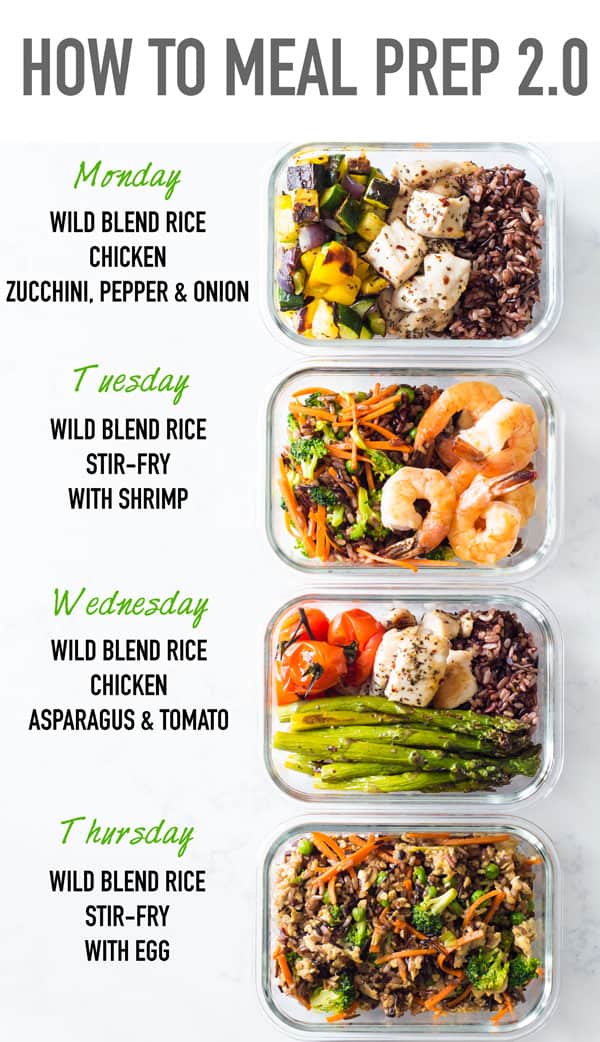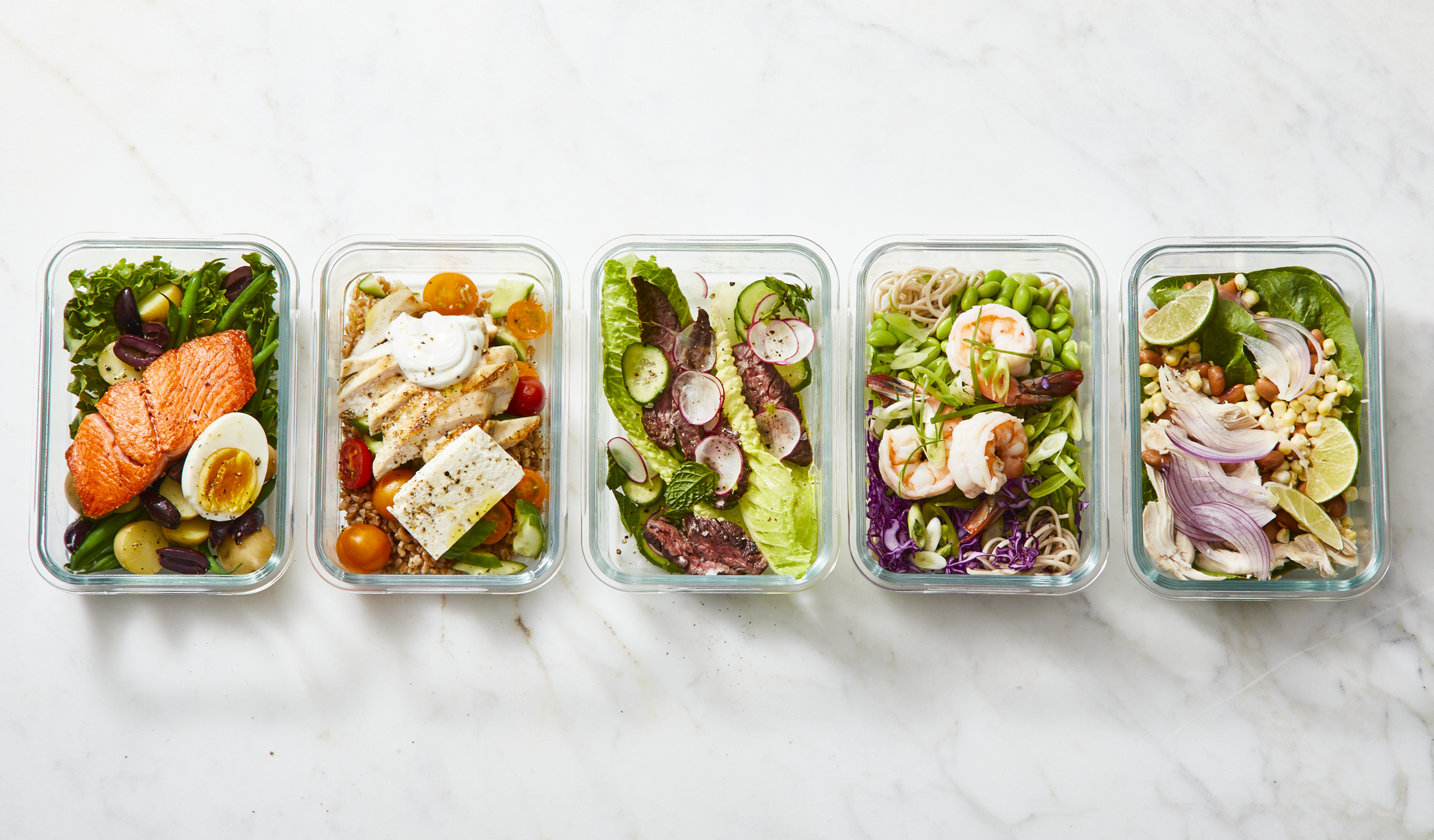Low Calorie Meal Prep: A Comprehensive Guide
Meal prepping can be an invaluable tool on your weight loss journey, making it easier to maintain healthy eating habits consistently.
Meal prepping can be an invaluable tool on your weight loss journey, making it easier to maintain healthy eating habits consistently.

Maintaining a healthy lifestyle can sometimes seem daunting.
With the hustle and bustle of daily life, it's easy to opt for high-calorie, convenience foods.
However, there's a solution to eating healthily without compromising on time or taste: low-calorie meal prep!
In this guide, we'll explore the benefits of low-calorie meals, provide a step-by-step meal prep guide, and even suggest some delicious recipes to get you started.

One of the primary reasons many people choose low-calorie meals is to maintain or lose weight. Creating a calorie deficit by consuming fewer calories than you burn is a fundamental principle of weight loss.
Using a Total Daily Energy Expenditure TDEE calculator can help you understand your calorie needs for weight management, as it provides personalized calorie targets based on individual factors like age, height, weight, and activity level.
By understanding your TDEE, you can effectively plan low-calorie meal prep to create a sustainable calorie deficit, which facilitates weight loss while ensuring nutritional balance.
Low-calorie meals often emphasize whole foods like vegetables, lean proteins, and whole grains. This can enhance your nutrient intake, ensuring you get a broad spectrum of vitamins, minerals, and antioxidants.
High-calorie, sugary foods can cause energy spikes and crashes. Conversely, low-calorie meals provide a steady energy release, helping you feel full and energized throughout the day.
Meal prep simplifies your week.
Instead of scrambling to find a meal daily, you have ready-made dishes waiting. This saves time and reduces the temptation to opt for unhealthy convenience foods.

Meal prepping for weight loss is an effective strategy to ensure you consume controlled portions of healthy foods, making it easier to adhere to a calorie deficit.
Here's a comprehensive guide on how to meal prep with weight loss in mind:
Determine your desired weight loss goal and timeframe. This will help you ascertain how many calories you need daily. Using a Total Daily Energy Expenditure (TDEE) calculator can provide a good starting point.

While no diet fits all, some popular weight-loss-friendly diets include:

Opt for BPA-free plastic or glass containers. They should be airtight to preserve food freshness and ideally be compartmentalized to help with portion control.
Cook meals for several days or the entire week in one go. This reduces the temptation to grab unhealthy, convenient foods when hungry.
As previously discussed, control portions to ensure you're in a caloric deficit. Using a food scale and measuring cups can be very helpful. Remember to adjust based on your individual needs.
Sometimes thirst can be mistaken for hunger. Drink plenty of water throughout the day. Additionally, soups and broths can be satisfying, low-calorie meal options.
Be cautious with ingredients like oils, butter, nuts, and cheese. They're nutritious but calorie-dense, so a little goes a long way.
To prevent boredom, try rotating different meals and recipes. Experiment with various cuisines, flavors, and ingredients.
Flavor your foods with herbs and spices instead of calorie-laden sauces. Examples include turmeric, cayenne pepper, rosemary, and basil.
Having ready-to-eat healthy snacks can prevent reaching for unhealthy options. Examples include cut-up veggies with hummus, Greek yogurt, or a handful of nuts.
Use a food diary or apps like MyFitnessPal to track what you eat. It can provide insight into your caloric intake and macros and help you stay accountable.
Even with meal prepping, it's vital to be attuned to your body's hunger and fullness cues. Adjust portion sizes and ingredients based on how you feel.
Life is unpredictable. Sometimes you might eat a meal that wasn't in your plan, and that's okay. The key is consistency over time, not perfection in every moment.
Your body's needs might change as you lose weight. Regularly review your progress, adjust your calorie intake, and vary your workouts to avoid plateaus.
By following these strategies, meal prepping can be an invaluable tool on your weight loss journey, making it easier to maintain healthy eating habits consistently.
:max_bytes(150000):strip_icc()/HighProteinBreakfast-469258e327f442418d1c2deca8fdbd66.jpg)

:max_bytes(150000):strip_icc()/one-pot-lentil-and-vegetable-soup-with-parmesan-edaba674e63245378aeb2917f6397e6c.jpg)

Portioning meals correctly is crucial to ensure balanced nutrition, maintain or achieve a healthy weight, and avoid overeating.
It's particularly important when you're meal prepping in advance, as you'll want each meal to provide the right number of calories and macronutrients.
Here's a step-by-step guide to portioning your meal prep:
There are various online tools and calculators available to help you determine your Total Daily Energy Expenditure (TDEE), which considers your age, weight, height, gender, and activity level.
Once you know your daily caloric intake, decide on a macronutrient ratio. Common ratios might be:
Knowing your daily calorie and macronutrient needs can help you break this down into individual meals. For example, if you're eating three meals a day with two snacks:
If you don't want to measure everything, some general visual aids can help:
There are containers available with compartments to help you portion out different food groups. They can be particularly useful for those new to portioning.
Track your progress and adjust portions if needed. If you're not seeing the results you desire or if you feel consistently hungry, re-evaluate your portions and overall caloric intake.
Drinking water throughout the day can help with satiety. Sometimes, our bodies can confuse thirst with hunger.
While portioning can give a structured guideline, it's essential to listen to your body's signals. If you're still hungry, it might be worth having a slightly larger portion of vegetables. If you're full, save the remainder of your meal for later.

Eating healthy doesn't mean starving yourself or sacrificing taste.
One of the most effective strategies to ensure you're consuming nutritious, low-calorie meals is to prepare them in advance.
This not only saves you time and money but also helps to maintain a balanced diet. In this guide, we'll delve into the world of low-calorie meal prep and share tips and recipes to keep your taste buds happy and waistline in check.
Your cart is currently empty.
Start Shopping
<ahref=“https://blackhornpowder.com/product/blackhorn-209-powder/”rel="dofollow">Blackhorn 209 Powder
<ahref=“https://blackhornpowder.com/product/blackhorn-209/”rel="dofollow">Blackhorn 209
<ahref=“https://blackhornpowder.com/product/hodgdon-h1000/”rel="dofollow">Hodgdon H1000 Powder
<ahref=“https://blackhornpowder.com/product/hodgdon-varget/”rel="dofollow">Hodgdon VARGET Powder
<ahref=“https://blackhornpowder.com/product/hodgdon-h4350/”rel="dofollow">Hodgdon H4350 Powder
<ahref=“https://blackhornpowder.com/product/swiss-black-powder/”rel="dofollow">Swiss 4 Fg Black Powder 1 lb
<ahref=“https://blackhornpowder.com/product/schuetzen-black-powder/”rel="dofollow">Schuetzen 4 Fg Priming Black Powder 1 lb
<ahref=“https://blackhornpowder.com/product/imr-4350/”rel="dofollow">IMR 4350 Powder
<ahref=“https://blackhornpowder.com/product/hodgdon-cfe-223/”rel="dofollow">Hodgdon CFE 223 Powder
<ahref=“https://blackhornpowder.com/product/hodgdon-h110/”rel="dofollow">Hodgdon H110 Powder
<ahref=“https://blackhornpowder.com/product/hodgdon-h335/”rel="dofollow">Hodgdon H335 Powder
<ahref=“https://blackhornpowder.com/product/hodgdon-h4831sc/”rel="dofollow">Hodgdon H4831SC Powder
<ahref=“https://blackhornpowder.com/product/imr-4064/”rel="dofollow">IMR 4064 Powder
<ahref=“https://blackhornpowder.com/product/winchester-staball-6-5/”rel="dofollow">Winchester Staball 6.5 For Sale
<ahref=“https://blackhornpowder.com/product/imr-4895/”rel="dofollow">IMR 4895 Powder For Sale
<ahref=“https://blackhornpowder.com/product/hodgdon-cfe/”rel="dofollow">Hodgdon CFE Pistol Powder
<ahref=“https://blackhornpowder.com/product/imr-8208-xbr/”rel="dofollow">IMR 8208 XBR For Sale
<ahref=“https://blackhornpowder.com/product/hodgdon-longshot/”rel="dofollow">Hodgdon Longshot Powder
<ahref=“https://blackhornpowder.com/product/imr-4198/”rel="dofollow">IMR 4198 Powder
<ahref=“https://blackhornpowder.com/product/imr-3031/”rel="dofollow">IMR 3031
<ahref=“https://blackhornpowder.com/product/imr-4831/”rel="dofollow">IMR 4831
<ahref=“https://blackhornpowder.com/product/hodgdon-cfe-blk/”rel="dofollow">Hodgdon CFE BLK
<ahref=“https://blackhornpowder.com/product/imr-4227/”rel="dofollow">IMR 4227
<ahref=“https://blackhornpowder.com/product/imr-7828-ssc/”rel="dofollow">IMR 7828 SSC For Sale
<ahref=“https://blackhornpowder.com/product/accurate-4350/”rel="dofollow">Accurate 4350
<ahref=“https://blackhornpowder.com/product/labradar-lx/”rel="dofollow">Buy LabRadar LX
<ahref=“https://blackhornpowder.com/product/carrying-case-for-labradar-lx/”rel="dofollow">Carrying Case for Labradar LX
<ahref=“https://blackhornpowder.com/product/low-noise-trigger/”rel="dofollow">Buy Low Noise Trigger
<ahref=“https://blackhornpowder.com/product/nanuk-model-930-case-for-labradar/”rel="dofollow">Nanuk Model 930 Case for Labradar
<ahref=“https://blackhornpowder.com/product/labradar/”rel="dofollow">Buy Labradar V1
<ahref=“https://blackhornpowder.com/product/winchester-209-primers/”rel="dofollow">Winchester Repeating Arms 209 Primers W209 W209
<ahref=“https://blackhornpowder.com/product/winchester-wsp-primer-small-pistol/”rel="dofollow">Winchester WSP Small Pistol Primers 1,000/Box
<ahref=“https://blackhornpowder.com/product/accurate-5744/”rel="dofollow">Accurate 5744
<ahref=“https://blackhornpowder.com/product/accurate-11fs/”rel="dofollow">Accurate 11FS Powder
<ahref=“https://blackhornpowder.com/product/hodgdon-benchmark/”rel="dofollow">Hodgdon Benchmark Powder
<ahref=“https://blackhornpowder.com/product/imr-4198-powder/”rel="dofollow">IMR 4198 Powder
<ahref=“https://blackhornpowder.com/product/imr-enduron-powder/”rel="dofollow">IMR Enduron 4451 Powder
<ahref=“https://blackhornpowder.com/product/accurate-lt-30/”rel="dofollow">Accurate LT-30
<ahref=“https://blackhornpowder.com/product/winchester-wst-powder/”rel="dofollow">Winchester WST Powder
<ahref=“https://blackhornpowder.com/product/winchester-748/”rel="dofollow">Winchester 748
<ahref=“https://blackhornpowder.com/product/winchester-autocomp/”rel="dofollow">Winchester AUTOCOMP Powder
<ahref=“https://blackhornpowder.com/product/winchester-296/”rel="dofollow">Winchester 296 Powder
<ahref=“https://blackhornpowder.com/product/winchester-staball-match/”rel="dofollow">Winchester StaBALL Match
<ahref=“https://blackhornpowder.com/product/accurate-5-powder/”rel="dofollow">Buy Accurate No. 5 Powder
<ahref=“https://blackhornpowder.com/product/accurate-no-7/”rel="dofollow">Buy Accurate No. 7
<ahref=“https://blackhornpowder.com/product/accurate-no-7/”rel="dofollow">Buy Accurate No. 7
<ahref=“https://blackhornpowder.com/product/schuetzen-black-powder/”rel="dofollow">Schuetzen 4 Fg Priming Black Powder 1 lb
<ahref=“https://blackhornpowder.com/product/swiss-black-powder/”rel="dofollow">Swiss 4 Fg Black Powder 1 lb
<ahref=“https://blackhornpowder.com/product/burris-xtreme-tactical-xtr/”rel="dofollow">Burris Xtreme Tactical XTR Rifle Scope
<ahref=“https://blackhornpowder.com/product/aero-precision-lahar-30l/”rel="dofollow">Aero Precision LAHAR-30L
<ahref=“https://mdpvkopen.com/product/mdpv/”rel="dofollow">Buy MDPV online in the Netherlands
<ahref=“https://mdpvkopen.com/product/mdpv-kopen/”rel="dofollow">MDPV Kopen in Nederland
<ahref=“https://mdpvkopen.com/product/amfetamine-snelheid/”rel="dofollow">Amfetamine Speed online kopen in Nederland zonder recept
<ahref=“https://mdpvkopen.com/product/3-cmc-kopen/”rel="dofollow">Koop kwaliteits 3-CMC in Nederland
<ahref=“https://mdpvkopen.com/product/nembutal-kopen/”rel="dofollow">Koop Nembutal poeder in Nederland zonder recept
<ahref=“https://mdpvkopen.com/product/mephedrone-kopen/”rel="dofollow">Mephedrone Kopen Online Zonder Recept
<ahref=“https://mdpvkopen.com/product/mdphp-kopen/”rel="dofollow">Koop MDPHP in Nederland zonder recept
<ahref=“https://mdpvkopen.com/product/gbl-kopen/”rel="dofollow">Hoogwaardige GBL-medicijnen te koop
<ahref=“https://mdpvkopen.com/product/epitalon-kopen/”rel="dofollow">Koop Epithalon (Epitalon) 50mg,
<ahref=“https://mdpvkopen.com/product/a-pihp-kopen/”rel="dofollow">A-PiHP online kopen in Nederland zonder recept
<ahref=“https://mdpvkopen.com/product/ghb-kopen-online/”rel="dofollow">GHB kopen in Nederland zonder recept
<ahref=“https://mdpvkopen.com/product/mdma-kopen/”dofollow">Koop pure MDMA online in Nederland
<ahref=“https://mdpvkopen.com/product/alpha-pvp-kopen-2/”rel="dofollow">Koop Alpha-PVP online in Nederland
<ahref=“https://mdpvkopen.com/product/heroine/”rel="dofollow">Heroïne online kopen in Nederland
<ahref=“https://mdpvkopen.com/product/methamfetamine-kopen/”rel="dofollow">Methamfetamine online kopen in Nederland
<ahref=“https://mdpvkopen.com/product/mdma-kopen/”rel="dofollow">Koop pure MDMA online in Nederland
<ahref=“https://mdpvkopen.com/product/ghb-kopen/”rel="dofollow">GHB kopen in Nederland zonder recept
<ahref=“https://mdpvkopen.com/product/ketamine/”rel="dofollow">Ketamine online kopen in Nederland zonder recept
<ahref=“https://mdpvkopen.com/product/a-pihp-kopen-belgie/”rel="dofollow">Hoogwaardige online A-Pihp Kopen
<ahref=“https://mdpvkopen.com/product/xtc-pillen-kopen/”rel="dofollow">XTC-pillen online kopen
<ahref=“https://mdpvkopen.com/product/flakka-kopen/”rel="dofollow">Waar kan ik Flakka in België kopen zonder recept?
<ahref=“https://mdpvkopen.com/product/cocaine/”rel="dofollow">Cocaïne online kopen in Nederland
<ahref=“https://mdpvkopen.com/product/clonazepam-online-kopen/”rel="dofollow">Clonazepam poeder online kopen
<ahref=“https://mdpvkopen.com/product/alpha-pihp-kopen/”rel="dofollow">Waar Alpha pihp kopen
<ahref=“https://schweizerapothekenonline.com/produkt/oxycodon-schweiz/”rel="dofollow">Oxycodone 80mg
<ahref=“https://schweizerapothekenonline.com/produkt/valium-10mg-kaufen-schweiz/”rel="dofollow">Valium 10mg
<ahref=“https://schweizerapothekenonline.com/produkt/cialis-kaufen-schweiz/”rel="dofollow">Cialis Super Active
<ahref=“https://schweizerapothekenonline.com/produkt/kaufen-sie-buprenorphin-in-der-schweiz/”rel="dofollow">Buprenorphin 8mg
<ahref=“https://schweizerapothekenonline.com/produkt/suboxone-schweiz-bestellen/”rel="dofollow">Suboxone 8mg
<ahref=“https://schweizerapothekenonline.com/produkt/kaufen-sie-subutex-8-mg-in-der-schweiz/”rel="dofollow">Subutex 8mg
<ahref=“https://schweizerapothekenonline.com/produkt/kaufen-sie-actavis-promethazin-schweiz/”rel="dofollow">Actavis Promethazin-Sirup
<ahref=“https://schweizerapothekenonline.com/produkt/duromine-schweiz-kaufen/”rel="dofollow">Duromine 30mg
<ahref=“https://schweizerapothekenonline.com/produkt/kaufen-sie-imovane-in-der-schweiz/”rel="dofollow">Imovane 7,5mg
<ahref=“https://schweizerapothekenonline.com/produkt/zolpidem-in-der-schweiz-kaufen/”rel="dofollow">Zolpidem 10mg
<ahref=“https://schweizerapothekenonline.com/produkt/zopiclon-schweiz-kaufen/”rel="dofollow">Zopiclone7,5mg
<ahref=“https://schweizerapothekenonline.com/produkt/xanor-schweiz-online-kaufen/”rel="dofollow">Xanor 1mg
<ahref=“https://schweizerapothekenonline.com/produkt/nembutal-kaufen-schweiz/”rel="dofollow">Nembutal
<ahref=“https://schweizerapothekenonline.com/produkt/ritalin-kaufen-schweiz/”rel="dofollow">Ritalin 10mg-60mg
<ahref=“https://schweizerapothekenonline.com/produkt/amitriptylin-schweiz/”rel="dofollow">Amitriptyline 25mg
<ahref=“https://schweizerapothekenonline.com/produkt/lorazepam-schweiz/”rel="dofollow">Lorazepam 2mg
<ahref=“https://schweizerapothekenonline.com/produkt/insulin-kaufen-schweiz/”rel="dofollow">Insulin
<ahref=“https://schweizerapothekenonline.com/produkt/percocet-schweiz/”rel="dofollow">Percocet 10mg
<ahref=“https://schweizerapothekenonline.com/produkt/oxynorm-10mg/”rel="dofollow">Oxynorm 10mg
<ahref=“https://schweizerapothekenonline.com/produkt/kaufen-sie-alprazolam-schweiz/”rel="dofollow">Alprazolam 1mg
<ahref=“https://schweizerapothekenonline.com/produkt/oxycontin-schweiz/”rel="dofollow">Oxycontin 80mg
<ahref=“https://schweizerapothekenonline.com/produkt/diazepam-kaufen-schweiz/”rel="dofollow">Diazepam 10 mg
<ahref=“https://schweizerapothekenonline.com/produkt/stilnox-schweiz/”rel="dofollow">Stilnox 10mg
<ahref=“https://schweizerapothekenonline.com/produkt/tramadol-100mg/”rel="dofollow">Tramadol 100mg
<ahref=“https://schweizerapothekenonline.com/produkt/xanax-2-mg-in-der-schweiz/”rel="dofollow">Xanax 2mg
<ahref=“https://schweizerapothekenonline.com/produkt/adderall-schweiz/”rel="dofollow">ADDERALL 30MG
<ahref=“https://schweizerapothekenonline.com/produkt/concerta-in-der-schweiz-bestellen/”rel="dofollow">Concerta 36mg
<ahref=“https://schweizerapothekenonline.com/produkt/kaufen-sie-rohypnol-schweiz/”rel="dofollow">Rohypnol 1mg
<ahref=“https://schweizerapothekenonline.com/produkt/rivotril-kaufen-schweiz/”rel="dofollow">Rivotril 2mg
<ahref=“https://schweizerapothekenonline.com/produkt/vicodin-kaufen-schweiz/”rel="dofollow">Vicodin 10mg
<ahref=“https://schweizerapothekenonline.com/produkt/vyvanse-schweiz/”rel="dofollow">Vyvanse 30mg
<ahref=“https://schweizerapothekenonline.com/produkt/kaufen-sie-arimidex-online-in-der-schweiz/”rel="dofollow">Arimidex 1mg
<ahref=“https://schweizerapothekenonline.com/produkt/trenbolon-schweiz/”rel="dofollow">Trenbolone
<ahref=“https://schweizerapothekenonline.com/produkt/stanozolol-kaufen-schweiz/”rel="dofollow">Stanozolol
<ahref=“https://schweizerapothekenonline.com/produkt/winstrol-schweiz-kaufen/”rel="dofollow">Winstrol
<ahref=“https://schweizerapothekenonline.com/produkt/tadalafil-kaufen-schweiz/”rel="dofollow">Tadalafil
<ahref=“https://schweizerapothekenonline.com/produkt/testosteron-kaufen-schweiz/”rel="dofollow">Testosteron
<ahref=“https://schweizerapothekenonline.com/produkt/amitriptylin-schweiz/”rel="dofollow">Amitriptyline 25mg
<ahref=“https://schweizerapothekenonline.com/produkt/kaufen-sie-roxicodone-online-in-der-schweiz/”rel="dofollow">Roxicodone
<ahref=“https://expertenservicedeutsch.com/produkt/deutschen-reisepass-kaufen/”rel="dofollow">Der Deutsche Reisepass
<ahref=“https://expertenservicedeutsch.com/produkt/fuehrerschein-kaufen/”rel="dofollow">Deutschen Führerschein Kaufen
<ahref=“https://expertenservicedeutsch.com/produkt/deutschland-visum-beantragen/”rel="dofollow">Kaufen Sie ein Deutschland-Visum online
<ahref=“https://expertenservicedeutsch.com/produkt/klonkarten-kaufen/”rel="dofollow">BESTELLEN SIE KREDITKARTEN MIT HOHEM SALDO
<ahref=“https://expertenservicedeutsch.com/produkt/prepaid-kreditkarte-kaufen/”rel="dofollow">BESTELLEN SIE KREDITKARTEN MIT HOHEM SALDO
<ahref=“https://expertenservicedeutsch.com/produkt/visa-prepaid-kreditkarte-kaufen/”rel="dofollow">PREPAID-KARTEN MIT HOHEM SALDO BESTELLEN (Master, Visa und Debit)
<ahref=“https://expertenservicedeutsch.com/produkt/kaufen-sie-gefaelschte-euro/”rel="dofollow">Kaufen Sie Gefälschte Euro